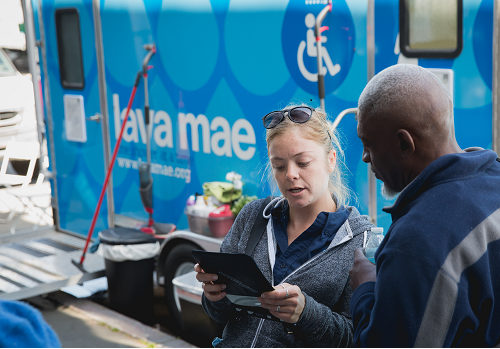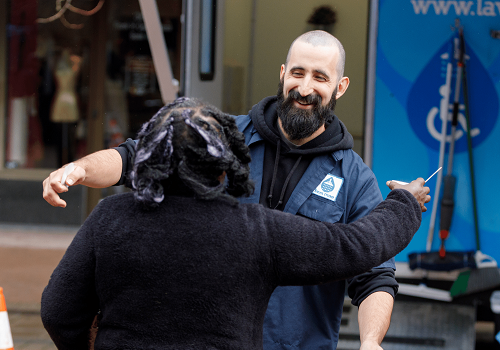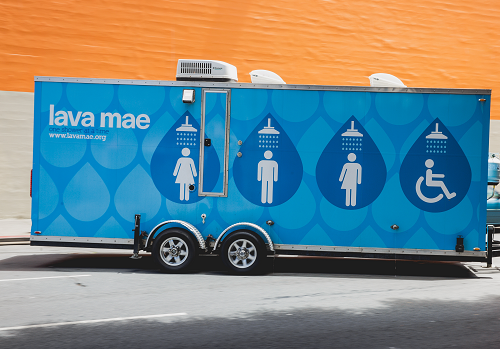The streets of many U.S. cities reveal an urgent reality: The current systems for addressing homelessness aren’t working. Lack of affordable housing and behavioral health resources, as well as poor coordination among programs and providers, are the most well-known reasons. But there’s another one we don’t hear about: The systems tasked with tackling this problem are not designed to serve the needs of their users.
Take Dan, a homeless veteran in Charlotte, North Carolina, who told staff at Project Outpour’s mobile hygiene unit that his attempt to find housing through the main service provider in town was more stressful than being homeless. “After months of back and forth, appointments, missed appointments, lack of follow-up, and major frustration and re-traumatization for Dan, he will hopefully be housed soon,” said Laura Gorecki, chief dignity officer and executive director of Project Outpour. Despite that potential progress, Dan is not convinced the process has been worth the struggle: “Living in a tent by myself is easier than dealing with all of this BS,” he told Project Outpour.
This is one of many such stories emerging from a LavaMaeX study of streetside service providers aimed at getting a better sense of what their unhoused guests confront. LavaMaeX, which mentors grassroots providers of mobile showers around the globe, surveyed nine providers in the U.S. and Calgary, Canada, and did follow-up interviews with six of them. Eight LavaMaeX staff members who provide streetside service also reported on their experiences.
The responses reveal a system whose design is working against its success. In most cases, the people it is supposed to serve don’t feel seen, valued or respected. They are re-traumatized by the application process; frustrated and jaded by providers who fail to do what they’ve promised; and stressed by a process that’s rife with inconsistencies, barriers, disconnections and lack of interpersonal warmth.
Community members often hear that people on the streets are resistant to accepting services, but we find the opposite is more often true. As one LavaMaeX team member put it, “People aren’t service resistant; the services are people resistant.”
To fix homelessness services, we must redesign whole systems to center the experiences and needs of unhoused people. Our study made clear what is missing from current systems: consistency and trustworthiness, a trauma-informed approach, and an understanding of what people really need.
Consistency and trustworthiness
Survey respondents frequently hear about the frustrating—even chaotic—experiences clients have had when trying to navigate systems, which breed mistrust and lead many to give up.
Unhoused people are put on endless waiting lists, told to seek services that turn out to be unavailable and asked to travel to far-flung locations or fill out difficult-to-access forms. Their case workers often are overloaded and burned out from the overstretched system and can only offer support within rigid parameters. When people do succeed in gaining access, services often fall short of what was promised.
Experiences like these make unhoused people feel like no one really cares about their situation and seeking services is not worth the hassle or the disappointment.
“Our clients have had so many people who should have been taking care of them show up, make some promises and then not be able to keep them. And that’s the best-case scenario,” said Sara Melucci, director of outreach for House of Hope CDC, an organization in Rhode Island known for providing night-to-night shelter in community-based homes. “Even more often, those people or institutions have done real harm.”
Trauma-informed processes
People seeking services are frequently asked to tell the story of how they ended up in a position of need, since this may influence what services they can access and how quickly. Doing this even once can be emotionally taxing, but lack of coordination among agencies and providers often re-traumatizes people by requiring them to retell the story again and again.
“I’m struck at how normal our social service systems make it to have to rehash your trauma over and over,” said Melucci. “So many times, our clients show up to a place and share their whole life story that’s filled with trauma, only to be told that they came to the wrong place.” This is true despite more than a decade of research affirming the need for trauma-informed care.
Shelter environments can also be traumatizing; the organizations surveyed report that people find shelters loud, unsafe and punishingly restrictive. Many do not allow children or pets. Theft is common. And some people can’t stay in shelters for mental health reasons. For example, Jeanne Albaugh, president and founder of Showering Love, a provider of mobile showers in Fort Lauderdale, Florida, was homeless for 10 years and couldn’t stay in shelters because her PTSD made it unbearable.
Organizations like Showering Love can connect with and serve the same people who feel re-traumatized by other providers because their staff members take a trauma-informed approach rooted in greeting people with compassion and support.
“We know where they are; we also know what’s possible for them,” said Albaugh. “We are their biggest cheerleaders.”
A true understanding of needs
Almost everyone surveyed said their guests believe most providers of homelessness services do not understand or respect them. Redesigning services throughout the system to improve effectiveness should start with listening to the needs of unhoused people, Gorecki said.
“We treat them like members of our community, because they are,” she said. “We design program changes and additions based on their input, not on what we think the community needs.”
A system in which all staff are primed to listen to clients with a whole heart would be a first step toward addressing the mistrust unhoused people feel toward municipal homelessness services providers.
More humane, effective systems are possible
What would a better system look like? It would prioritize the needs of unhoused people instead of the needs of policymakers and agency heads charged with running the system. All workers within it would be trained to provide consistent, trauma-informed service and have the flexibility to meet individuals’ most urgent needs. It would leverage the knowledge of streetside service providers and adopt their relationship-building approach, which helps people move on with their lives..
A system like this might sound too expensive. But is it? Consider the costs of continuing with the current failed design: huge expenditures on emergency room admissions, policing, street cleaning, incarceration and revolving door solutions. And those are just the monetary costs. The human costs—to people living on the streets, obviously, but also to all of us—are deeper and longer lasting. What is the price when we decide some of our neighbors aren’t fully human? Or just give up on them?
The crisis on our streets has sparked a significant, and in some cities rising, flow of money into homelessness solutions. But if we’re just bolting enhancements onto fundamentally flawed systems, we’ll keep getting the same poor results. Our survey revealed that systems are not just bogged down in bureaucratic inefficiency; they’re actually hurting people. Now is the time to redesign services so that they are no longer people resistant, but instead are people driven.
Kris Kepler is CEO of LavaMaeX, a nonprofit that teaches people around the world to bring mobile showers and other essential care services to the street, where unhoused people need them most.




